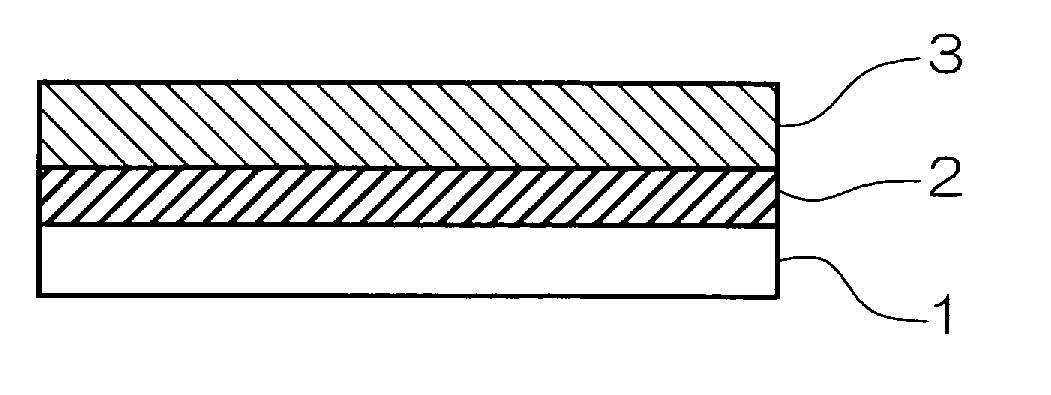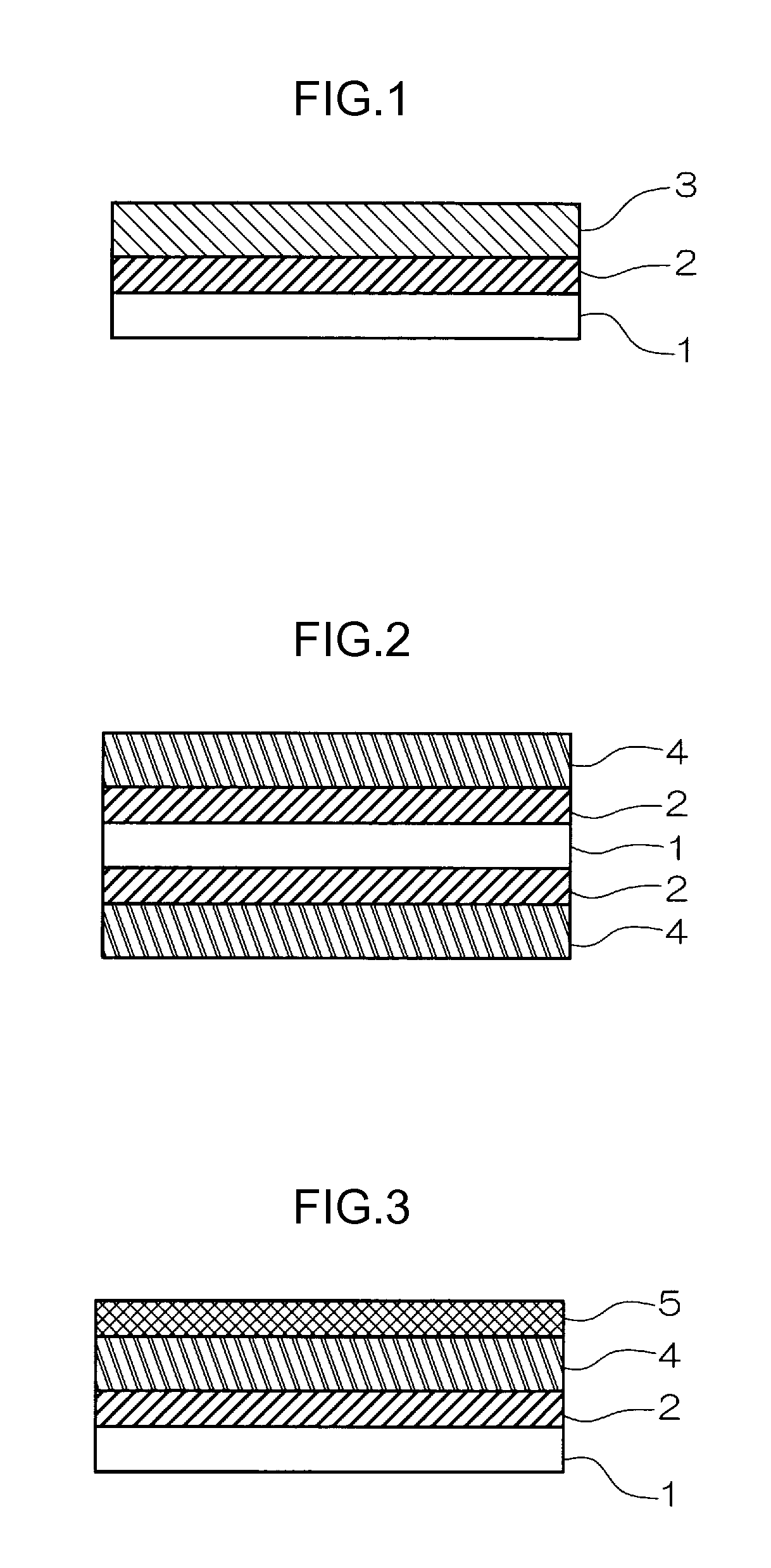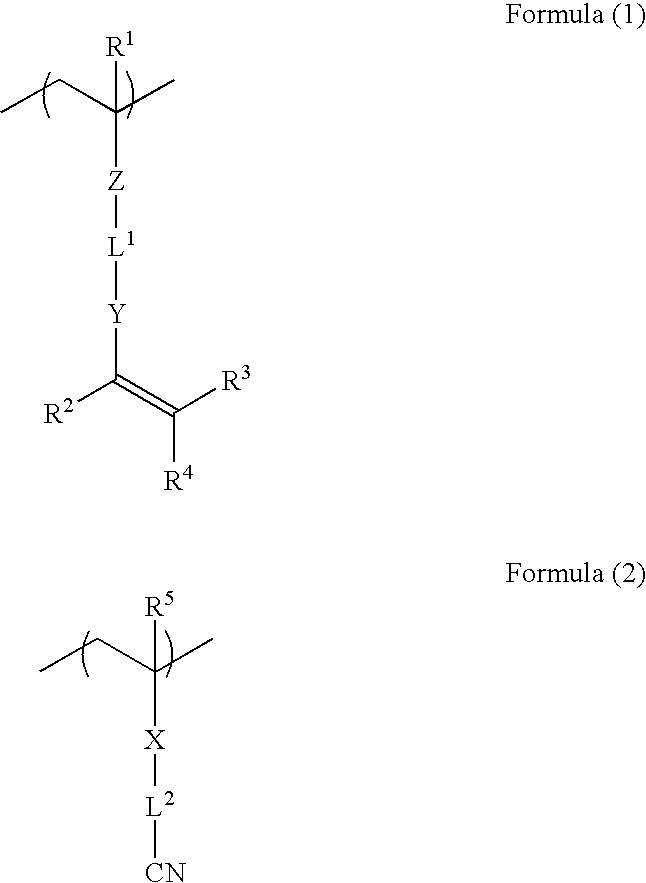Conductive substance-adsorbing resin film, method for producing conductive substance-adsorbing resin film, metal layer-coated resin film using the same, and method for producing metal layer-coated resin film
a technology of conductive substance and resin film, which is applied in the direction of other chemical processes, liquid/solution decomposition chemical coating, coating, etc., can solve the problems of inability to form fine wirings, inability to achieve sufficient adhesion between metal layer and insulating resin film, and complex operation, etc., to achieve excellent adhesion and less unevenness
- Summary
- Abstract
- Description
- Claims
- Application Information
AI Technical Summary
Benefits of technology
Problems solved by technology
Method used
Image
Examples
embodiment (
2-2) wherein both the polymerization modes are radical polymerization
[0202]In the embodiment wherein both the polymerization modes are radial polymerization, the synthesis method may be a method (i) wherein a monomer having a cyano group is copolymerized with a monomer having a polymerizable group, a method (ii) wherein a monomer having a cyano group is copolymerized with a monomer having a double bond precursor and then treated with a base or the like to introduce a double bond into the product, and a method (iii) wherein a polymer having a cyano group is reacted with a monomer having a polymerizable group thereby introducing a double bond (introducing the polymerizable group) into the polymer. Among these methods, the method (ii) wherein a monomer having a cyano group is copolymerized with a monomer having a double bond precursor and then treated with a base or the like to introduce a double bond into the product and a method (iii) wherein a polymer having a cyano group is reacted...
example 1
Synthesis of Polymer P1 Having Polymerization Initiation Groups
[0349]30 g of propylene glycol monomethyl ether (MFG) was introduced into a 300-mL three-neck flask and then heated to 75° C. A solution consisting of 8.1 g of [2-(acryloyloxy)ethyl](4-benzoylbenzyl)dimethyl ammonium bromide, 9.9 g of 2-hydroxyethyl methacrylate, 3.5 g of isopropyl methacrylate, 0.43 g of dimethyl-2,2′-azobis(2-methylpropionate), and 30 g of MFG was added dropwise over 2.5 hours thereto. Thereafter, the reaction temperature was increased to 80° C., and the mixture was further reacted for 2 hours, to yield polymer P1 having polymerization initiation groups.
Formation of Adhesion Assist Layer 2 Containing an Initiator
[0350]20 parts by weight (hereinafter, compounding amounts are expressed in parts by weight) of bisphenol A type epoxy resin (trade name: Epicoat 828, epoxy equivalent 185, manufactured by Yuka-Shell Epoxy Co., Ltd.), 45 parts of cresol novolac type epoxy resin (trade name: Epiclon N-673, epoxy...
example 2
[0356]A conductive substance-adsorbing resin film in Example 2 was formed in the same manner as in Example 1 except that for the polyimide film that is a resin film in Example 1, a film having a hole of 200 μm in diameter formed by drilling was used as a resin support 1.
PUM
| Property | Measurement | Unit |
|---|---|---|
| Adhesion strength | aaaaa | aaaaa |
| Molecular weight | aaaaa | aaaaa |
| Electrical conductor | aaaaa | aaaaa |
Abstract
Description
Claims
Application Information
 Login to View More
Login to View More - R&D
- Intellectual Property
- Life Sciences
- Materials
- Tech Scout
- Unparalleled Data Quality
- Higher Quality Content
- 60% Fewer Hallucinations
Browse by: Latest US Patents, China's latest patents, Technical Efficacy Thesaurus, Application Domain, Technology Topic, Popular Technical Reports.
© 2025 PatSnap. All rights reserved.Legal|Privacy policy|Modern Slavery Act Transparency Statement|Sitemap|About US| Contact US: help@patsnap.com



